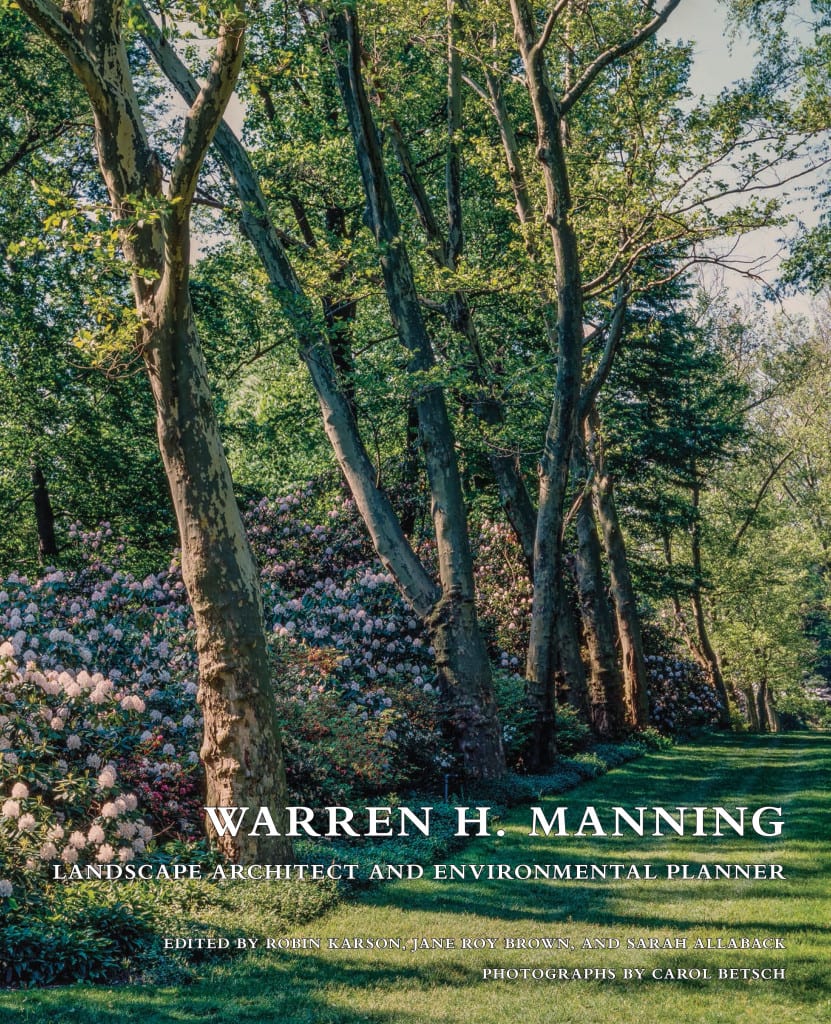Warren H. Manning
Landscape Architect and Environmental Planner
Edited by Robin Karson, Jane Roy Brown, and Sarah Allaback
With photographs by Carol Betsch
University of Georgia Press in association with LALH
| ISBN: 978-0-8203-5066-0 | 416 pages | 9 x 11 inches |
| $39.95 | Cloth | Published: 04/01/2017 |
| 350 color and b&w photos and drawings | |
A volume in the series Critical Perspectives in the History of Environmental Design
Warren H. Manning’s (1860–1938) national practice comprised more than 1,600 landscape design and planning projects throughout North America, from small home grounds to estates, cemeteries, college campuses, parks and park systems, and new industrial towns. Manning approached his design and planning projects from an environmental perspective, conceptualizing projects as components of larger regional (in some cases, national) systems, a method that contrasted sharply with those of his stylistically oriented colleagues. In this regard, as in many others, Manning had been influenced by his years with the Olmsted firm, where the foundations of his resource-based approach to design were forged. Manning’s overlay map methods, later adopted by the renowned landscape architect Ian McHarg, provided the basis for computer mapping software in widespread use today.
One of the eleven founders of the American Society of Landscape Architects, Manning also ran one of the nation’s largest offices, where he trained several influential designers, including Fletcher Steele, A. D. Taylor, Charles Gillette, and Dan Kiley. After Manning’s death, his reputation slipped into obscurity. Contributors to the Warren H. Manning Research Project have worked more than a decade to assess current conditions of his built projects and to compile a richly illustrated compendium of site essays that illuminate the range, scope, and significance of Manning’s notable career.
"Manning's importance comes across in his dedication to understanding the environment of particular areas and regions and thinking about broader environmental planning objectives in his projects. With absorbing source material such as the projects found in this publication, future scholars and historians can immerse themselves in Manning's built work and continue to elucidate various aspects of his career, expanding our understanding of this significant figure for American landscape and planning history."
"Casual readers will be delighted to discover how many of his projects they are familiar with, and practitioners and professionals will find this to be an invaluable guide to what is known about Manning's life and work, and what remains to be discovered."
"Manning's always been something of a cipher in landscape architectural history, and this book does a good job in clearing away some of the murkiness that has existed around him and his career. The overview essay, in particular, provides new insights into Manning's life, personality, and motivations; it also sheds light into the nature of 'office practice' in the profession's early years, as Manning moves from junior designer at the Olmsted firm to sole practitioner."
2018 J. B. Jackson Book Prize from the Foundation for Landscape Studies
2017 Outstanding Academic Title, Choice
About the Authors
Robin Karson
Robin Karson, Hon. ASLA, is the founder and executive director of LALH and the author of more than one hundred articles and several books on American landscape history, including (as coeditor) Warren H. Manning, Landscape Architect and Environmental Planner; A Genius for Place: American Landscapes of the Country Place Era; Fletcher Steele, Landscape Architect; The Muses of Gwinn, and the new introduction to the LALH revised edition of Fletcher Steele’s Design in the Little Garden. Her work has been recognized with awards from the American Society of Landscape Architects, the Foundation for Landscape Studies, the American Horticultural Society, and the Institute for Classical Architecture and Art. In addition, she has organized several touring exhibitions for LALH on topics relating to American landscape history. In 2004, Karson was named a distinguished member of the Honor Society of Sigma Lambda Alpha for her “continued high-quality contribution to the scholarship of landscape architecture and the literature of landscape architecture history.” In 2017, she was made an honorary member of the American Society of Landscape Architects.
Jane Roy Brown
Jane Roy Brown is the coauthor of One Writer’s Garden: Eudora Welty’s Home Place. She served as LALH Director of Educational Outreach, and was a frequent contributor to VIEW.
Sarah Allaback
Sarah Allaback is senior manuscript editor at LALH. A coeditor of Warren H. Manning, Landscape Architect and Environmental Planner and co-author of Improving the Village, she is author of Marjorie Sewell Cautley, Landscape Architect for the Motor Age and The First American Women Architects.
